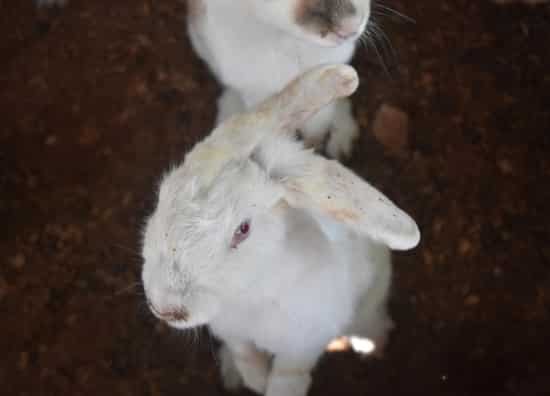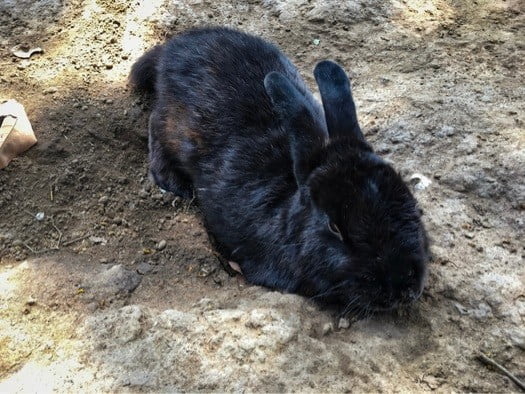Rabbit hind leg problems are very common. In fact, all pet rabbits will experience weak, wobbly or shaky hind legs if they live beyond a certain age. Sickness and traumatic injury can escalate these physical issues and lead to paralysis, if not treated. Wear and tear isn’t the only medical concern.
Joint problems are a common reason for leg weakness. Also, ensure your rabbit’s leg is not sprained or fractured. Spinal complications (fused vertebrae, swollen discs or dislocated bones) are a constant risk. Test for bacteria in the legs or feet, and ensure your rabbit is not overheating. Get veterinary checks for severe medical concerns such as cancer or stroke.
A rabbit that’s unable to use their hind legs needs assistance. The loss of hind legs will have a detrimental impact on your rabbit, and put their health at risk. This guide explores the various potential explanations for your rabbit’s sudden loss of mobility.
How Does a Rabbit Use Their Hind Legs?
The hind legs are arguably the most crucial part of a rabbit’s anatomy. Rabbits use their legs for a variety of essential day-to-day activities.
This is a rabbit’s preferred mode of movement. Rabbits can walk on a leash, if trained, but find this restrictive. They’d rather hop and leap to their preferred location.
The powerful hind legs of a rabbit ensure they move at speed. This is critical to wild rabbits, which are continually fleeing predators. By pushing with their powerful back legs, a rabbit can sprint at speeds of up to 50 miles per hour.

A rabbit will also stand on their hind legs. This usually means they are looking out for predators, or begging. Naturally, this means that a rabbit’s hind legs must support their body weight.
Rabbits also use their rear legs to groom themselves. A bunny’s long, hind legs can reach difficult spots on their back. This helps a rabbit relieve itching, or smooth over ruffled fur.
These varied duties make the back legs of a bunny pivotal. Unfortunately, they also experience wear and tear. Old rabbits, in particular, struggle with weak and wobbly hind legs.
If you ever spot your rabbit limping, it must be taken seriously.
Rabbit Hind Legs Anatomy
A bunny’s hind legs are divided into three core elements: the foot, the leg, and the thigh.
Rabbits Feet
A rabbit primarily uses its feet as a shock absorber and launchpad. Bunnies are so fleet of foot because they run on their toes. Keeping their hind feet on the ground gives them the grounding to start to spring.
Rabbits Thighs
The thigh is the most critical part of a rabbit’s leg as this is where the muscles are found. Bunnies have thigh muscles comparable to an Olympic athlete. They pack plenty of power into their small frame, which provides acceleration.
Rabbits Legs
Below the thigh and above the foot is the leg itself. A rabbit’s hind leg is long and mobile. The bones within them are brittle, though. This can lead to complications if a rabbit suffers a fracture.
The delicacy of a rabbit’s hind legs means they must always be handled with care. If your rabbit breaks a leg, they may never be the same again.
My Rabbit Has Hurt Their Back Leg
A rabbit can injure itself in many ways. The most glaring risk is a fracture caused by mishandling, or a fall from height. There are other risk factors, though.
If your rabbit’s hutch is too small, a bunny can twist their legs into unnatural positions. This leads to the rabbit dislocating their leg from their spine. As PetMD explains, this known as luxation.
Luxation causes paralysis in a rabbit’s hind legs. This may be partial or complete, depending on how severe the dislocation is. This also affects your bunny’s recovery.
In the case of mild to moderate luxation, a rabbit typically makes a full recovery. This takes time, though. It could be three months before your rabbit is back to their old self.
Treatment revolves around rest and patience. Your rabbit will not start to recover until the swelling reduces. Corticosteroids will help with this. Your bunny may also need pain management medication.
Your rabbit will be hutch-bound throughout this time, and likely fed up. Spend as much time with them as you can. Your bunny should not become excited or over stimulated, but neither should they bored or lonely. This leads to depression in rabbits.
If your rabbit has completely severed their leg from their spinal cord, it’s more problematic. Such rabbits may never make a full recovery. Seek specialist help in such an instance.
My Rabbit Has a Broken Hind Leg
If your bunny breaks their leg, it could be more or less traumatic than a dislocation. It depends on the cleanliness of the break, and the extent of the damage.
You’ll have to watch carefully for the signs of a broken leg, though. Rabbits are adept at hiding pain. They will not come to you for help. If your bunny will not put any weight on a hind leg, it’s worth arranging an x-ray.
Professional intervention on a broken leg will involve a splint or pins. This could cost up to $1,500 if your bunny is not insured.
Making a homemade splint is possible. Wrap the leg in gauze, apply a splint (popsicle sticks will do), and secure them in place. Don’t wrap the leg too tight, though. This will reduce blood flow, which can cause necrosis in the limb.
The most important thing after this is rest. Your bunny cannot use their broken limb for the next 6-8 weeks. This means they must remain calm, in their hutch.
One way to make this more bearable is to offer your bunny some willow bark. They’ll enjoy chewing this, and it contains a natural aspirin. This means that it doubles as pain relief. You’ll have to monitor the quantity you offer.
My Rabbit is Wobbly on Their Back Legs
Wobbly hind legs could point to a unique condition. This is known as Floppy Rabbit Syndrome, or FRS. This is a neurological issue that prevents rabbits from hopping.
FRS presents as wobbly hind legs and weak neck muscles. It’s usually diagnosed after alternative explanations are exhausted. If x-rays show no spinal damage and blood tests reveal no abnormalities, FRS is what’s left.
A rabbit with FRS issue can still eat, drink and eliminate. They’ll be reluctant to move in order to fulfill these tasks, though.

Information on FRS is thin on the ground. Experts are yet to assert precisely what causes the condition. Ingestion of toxins and bacteria has been posited, as has a vitamin deficiency. Alas, no evidence exists to support these theories.
This makes care for a bunny with FRS difficult. With no explanation for the cause, medication is not an option. Treatment can involve round-the-clock nursing.
A rabbit with FRS must be encouraged to eat and drink regularly, and be cleaned up after elimination. If the rabbit does not develop a secondary condition, they’ll recover in a few days.
My Rabbit’s Back Legs are Twitching and Shaking
A rabbit’s back legs shaking and twitching may be a consequence of overheating. A rabbit needs to run a body temperature of 101-103 degrees Fahrenheit. Any higher and they’ll become uncomfortable.
As My House Rabbit explains, other symptoms of hyperthermia in rabbits include:
- Reddened ears. Your pet’s ears will also be hot to the touch.
- Uncharacteristic lethargy.
- General confusion and clumsiness in movement.
- Panting, drooling and salivating.
A rabbit that is overheating must be removed from a heat source. Do not douse them in cold water. This will put your bunny into shock.
Offer your bunny cool water, and try to mist their ears. Working from the top down is the fastest and safest way to cool a rabbit off.
Grooming your bunny to remove any excess fur. If you have cold tiles in the home, place your rabbit on them. This will cool off their tummy.
If your rabbit is running a normal temperature, heat is not the issue. Twitching legs can be a warning sign of impending paralysis. The weakening of the rabbit’s hind legs can be a gradual process.
My Rabbit’s Back Legs are Not Moving
When your rabbit’s hind legs suddenly seize up, it’s worrying. This happens to almost every bunny at some point in their life. It’s particularly common in older rabbits, though.
This is because a bunny’s hind legs experience a significant amount of wear and tear. Eventually, the muscles will start to give way.
There could also be a disease or injury at play. Always rule out the possibility of a fracture or dislocation. Requesting an x-ray can do this. You should also have your rabbit’s blood tested. This will reveal any disease of toxicity.
What Causes Sudden Hind Leg Paralysis in Rabbits?
Physical trauma is always a possibility. Even if you didn’t see your bunny hurt themselves, it doesn’t mean it didn’t happen. Some of the additional explanations for hind leg paralysis include:
- Spinal Spondylosis. Your rabbit may have an issue with their spine. A common ailment is spondylosis, which sees multiple vertebrae fuse together.
- Intervertebral Disc Disease (IVD). This condition sees an intervertebral disc in your pet’s spine swell and bulge. This impacts the nerves, and prevents your rabbit from using their hind legs.
- Ingestion of Toxins. If your rabbit eats a toxic substance, they cannot vomit to remove it. Paralysis is a symptom of toxicity, alongside shallow breathing and general lethargy.
- Stroke. This can cause muscle paralysis. Stoke is a likelier explanation if your bunny appears to be paralyzed throughout one side of their body.
- Cancer. Unspayed female rabbits are at enhanced risk of uterine cancer. All rabbits are at risk of lymphoma or bone cancer. If these cells attack the spinal cord, paralysis is likely.
Professional help will be required to assert exactly what is causing your rabbit’s paralysis. You’ll need access to complex machinery that’s not available in the home.
How is Sudden Hind Leg Paralysis in Rabbits Treated?
Spinal issues are treated with anti-inflammatories and pain medication. Rest and recuperation are also pivotal. With time and patience, your rabbit will recover once the swelling subsides.
Toxins must be handled with care. Rabbits are physically incapable of vomiting as their stomach muscles lack strength. So, toxic substances are usually flushed out with intravenous fluids.
There is no fixed treatment plan for strokes. It depends on how severely your rabbit was impacted. If the quality of life is compromised, euthanasia may be considered the humane course of action.
Cancers will be tackled by surgically removing the tumor. This will be followed by chemotherapy or radiotherapy is necessary. If there is a risk of the disease spreading, amputation may be required.
My Rabbit is Dragging Their Back Leg
If you spot your rabbit dragging a leg, the likeliest explanation is encephalitozoon cuniculi. This is a parasite that impacts a rabbit’s kidneys, brain or spine.
The latter impacts the back legs. They’ll become unsteady, and painful to use. Your rabbit will drag their hind legs, as they don’t trust them to carry their weight. Full paralysis may eventually follow.
Encephalitozoon cuniculi is shared between rabbits when the spores are inhaled. This usually happens through bunny urine. It can also be passed on in utero, though.
This parasite is troublesome to detect. Over half of all rabbits are believed to carry it, but just 6% show symptoms. Additional warning signs of Encephalitozoon cuniculi include:
- Head tilting and spasms of the neck.
- Incontinence
- Discharge from the eyes.
Encephalitozoon cuniculi is diagnosed through a blood test. If the parasite is detected, it is killed using steroids. How your bunny responds depends on how advanced their parasitic infection is.
This parasite can survive for up to a month in rabbit urine. Disinfectant kills it, though. Regular cleaning of your bunny’s hutch will keep it at bay.
If your bunny is diagnosed with Encephalitozoon cuniculi, wear gloves when handling and cleaning them. The parasite is zoonotic, and can impact upon humans. Somebody with a weak immune system will be made sick.
My Rabbit is Limping
Limping is a warning sign that your rabbit has a fracture. They will limp because their leg cannot carry their weight. It may be an issue with their foot, though.
Take a look at your bunny’s hock. This is the part of your bunny’s hind leg that rests on the ground. If the hock is red, inflamed or covered with sores, your rabbit has a bacterial infection.
The most common example of this is ulcerative pododermatitis, better known as bumblefoot. Bumblefoot is sore for a bunny to live with, and must be treated. The condition is typically divided into five grades:
- Grade I – This is a mild condition. Your rabbit will experience some hair loss around the foot. They may barely notice the problem, though.
- Grade II – This is slightly more troublesome than Grade I. In addition to hair loss, your bunny’s feet will be red and swollen.
- Grade III – By now, your rabbit will be in pain. The skin on their feet will also break open. This leaves them at risk of infection.
- Grade IV – Bumblefoot of this grade must be quickly treated. Abscesses will form, and infection will quickly spread.
- Grade V – Your bunny will be unable to walk by this stage. The swelling will be problematic, and they’ll be in constant pain.
If your rabbit has bumblefoot, ensure their hutch is clean and has a soft floor. Wash their feet with antibacterial soap, and apply an antibacterial ointment. Bandage your bunny’s feet, or dress them in socks, until the issue is resolved.
If bumblefoot persists, prescription antibiotics will be required. Your bunny will also need painkillers, if this is the case.
My Rabbit Can’t Stand Up
If your rabbit is unable to stand up, their hind legs cannot support their weight. This could be due to any of the traumas or illnesses that we have previously discussed.
Before you panic, though, consider whether your rabbit is just too heavy. Obesity in rabbits is a common problem. Excess body mass cannot be carried by a rabbit’s muscular but thin legs.
The ideal body weight for your rabbit depends on their breed. As a rule, you should be able to feel their ribs. Their bottom should be flat, and their pelvis should be round, not sharp.

If you’re concerned about your bunny’s weight, watch their diet and exercise. Stop feeding pellets for a while, and stick with unlimited hay. Ensure that your rabbit exercises for around four hours a day.
This may be slow going at first. Overweight rabbits will not be as energetic as they could be. Over time, though, they’ll drop the excess pounds. This will encourage them to move more, and they’ll feel better.
Does Arthritis Impact a Rabbit’s Back Legs?
Any rabbit can get arthritis. It’s most common in older bunnies, over the age of 6. A rabbit as young as 2 can be diagnosed, though. Two types of arthritis impact rabbits:
- Osteoarthritis. This occurs when a rabbit’s joints endure years of use. Old age and excess weight can accelerate the condition.
- Septic Arthritis. This occurs when a rabbit experiences injury or trauma. The infection enters the wound site, and causes arthritis.
Either of these conditions will render your bunny’s hind legs stiff and challenging to use. This means they’ll struggle to hop, climb into a litter tray, or exercise. The more lethargic your rabbit becomes, the worse their arthritis will become.
There is no cure for arthritis in rabbits. The pain can be managed through medication and supplements, though. Massage will also ease your pet’s discomfort.
Aim to minimize the impact of arthritis and stiff joints in rabbits. This will help your rabbit retain use in their hind legs. Soft bedding and a healthy diet are critical. The more weight your bunny gains, the worse their arthritis will become.
What is Hip Dysplasia in Rabbits?
Alongside arthritis, hip dysplasia is a common ailment in rabbits. This condition is sometimes referred to as splay leg. If left untreated, spay leg can lead to paralysis.
This is a musculoskeletal issue that leaves a rabbit unable to retract their limb. It will be visible. At least one leg will be positioned at a different angle to the others. This could be up to 90 degrees.
Hip dysplasia is a congenital disability in rabbits. If a parent lives with the condition, their offspring will often inherit it. Usually, it will be visible from birth. If not, it typically manifests within weeks.
Hip dysplasia is treated with a leg brace. The University of Miami explains how you can make a brace at home. With lifestyle adjustments, a braced rabbit will still enjoy a full and happy life.
Will a Massage Help My Rabbit’s Hind Legs?
You may recall that we compared a rabbit’s hind legs to those of an Olympic athlete earlier in this guide. These individuals have physiotherapists taking care of their legs through massage. You can do the same for your rabbit.
Massage can be helpful for bunnies. Not only does it help repair and relax their leg muscles, but they find it pleasurable. This means that it will aid you bond with your bunny.
There are two primary forms of massage for rabbits; effleurage and petrissage. The former is best for beginners. Once you have mastered this, the kneading involved in petrissage will benefit your bunny.
Effleurage
Effleurage is the most common form of bunny massage. To perform this:
- Place your bunny in a relaxed position. If their posture has suffered due to hind leg problems, prop them up with towels.
- Tap your rabbit’s feet, and softly knead their toes. This will wake your rabbit’s nerves up a little.
- Move to your rabbit’s face, and gently stroke their cheeks and the top of their head.
- Stroke down your rabbit’s spine, stopping before the tail. Just use the tips your fingers, without too much pressure. Effleurage is a light sensation, not a deep tissue massage.
- Once you have covered your rabbit’s back, repeat the same trick on their joints. Apply gentle pressure to the muscles in short, sharp bursts. Apply emphasis to the hind legs.
If your rabbit takes to effleurage, you may wish to step up their treatment. A more intense form of therapy is called petrissage.
Petrissage
Petrissage involves kneading, and will unlock muscle tightness. Don’t attempt petrissage until you have mastered effleurage, and you’re confident that your bunny enjoys it. The process involves:
- Start the same way as you would with effleurage. Position your rabbit, awaken their feet, and gently stroke the face and cheeks.
- After a minute or two, increase pressure in these areas and start kneading. The top of the head will particularly benefit. Never knead a rabbit’s neck, though. The bones here are brittle.
- Perform effleurage on your bunny’s spine to warm them up. Then, start kneading their shoulders.
- Move down the spine, from the shoulders to the hips. Keep kneading, without applying too much pressure. Do not knead the bottom of the spine. This will spook your rabbit.
- Move to the legs. Knead all around the outside of your bunny’s joints. Don’t knead inside their thighs, as this will be painful.
- Finish off with some light effleurage.
If you get your rabbit into a routine with these treatments, they’ll love you for it. Massage will not cure medical conditions, but it keeps your pet’s hind legs supple. This reduces the risk of paralysis through wear and tear.
Will Surgery Help My Rabbit Use Their Hind Legs?
A study published in Laboratory Animals suggests that leg surgery can be beneficial to bunnies. Experimental surgery found that an incision on the peroneal nerve was comparatively painless.
This procedure is described as a muscle-sparing approach. This, theoretically, dictates that a bunny will enjoy healthy and functional hind legs for longer. Some pet parents consider this a fair trade for the risks of surgery.
No ill effects or post-operative pain was reported in the 24 rabbits operated upon. As a result, the Institute for Laboratory Animal Science at the University of Zurich recommend the procedure.
No rabbit should undergo surgery for no reason. A healthy rabbit is best left alone. This operation remains an option if you can find a suitable animal surgeon, though.
Will My Rabbit Need Their Hind Leg Amputated?
As Disabled Rabbits explains, amputation is sometimes the only option for a rabbit. This will not be a decision taken lightly. If it saves a rabbit’s life, though, it remains on the table.
Leg fractures are the most common reason for amputation. If the bones will not heal by themselves, drastic action is necessary. If ignored, the bones can repair out of place and create ongoing issues.
Disease in the leg can also necessitate amputation. If the infection is likely to spread, it must be cut out at the source. Cancer is the likeliest example of this.
Although amputation is a significant procedure, it is comparatively straightforward. It’s deemed a low-risk surgery, and most rabbits recover quickly.
Can Rabbits Live with Three Legs?
Despite their reliance on their hind legs, most rabbits adapt well to amputation. They’ll struggle with their balance initially, but will master it eventually.
If a vet recommends euthanasia over amputation, seek a second opinion. Rabbit care is a specialist field, and not all vets have the relevant expertise.
If your rabbit has three limbs, you’ll need to help them out with cleaning. Ears will be a particular problem, as they use their hind legs for this.
You’ll also need to ensure that your rabbit stays healthy. With a missing limb, the remaining three have an increased burden due to carrying body weight. This makes obesity difficult for your three-legged bunny to cope with.
A rabbit with a missing limb can still live a full and happy life. They’ll still run and play as before. It will just take them a little time to adapt.
Rabbit leg problems are commonplace, but serious. Never ignore a rabbit experiencing issues with their hind legs. Assuming that they’ll resolve themselves in time can lead to permanent damage.

